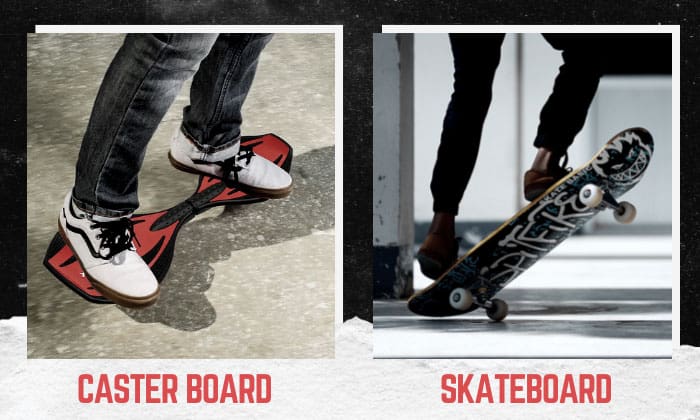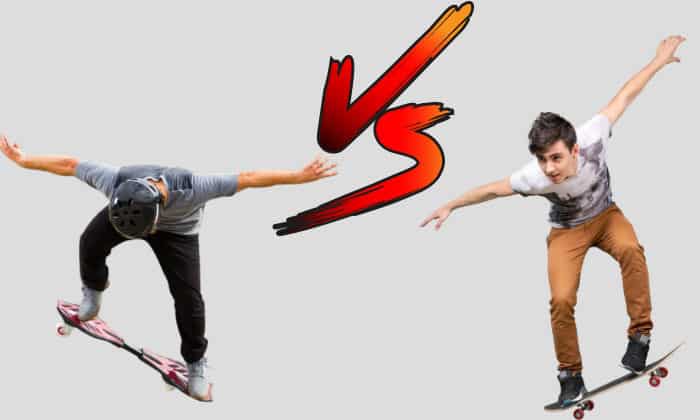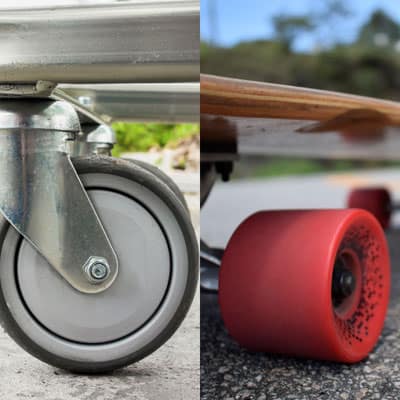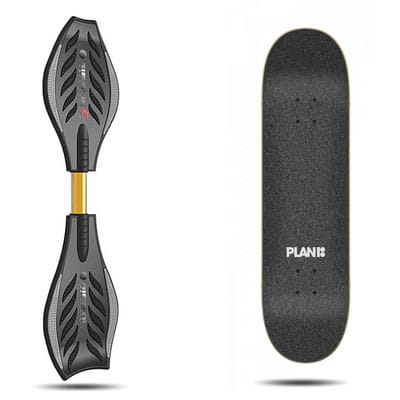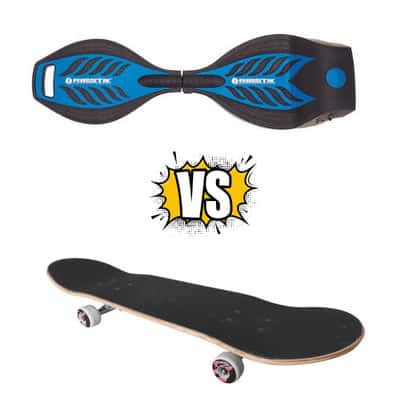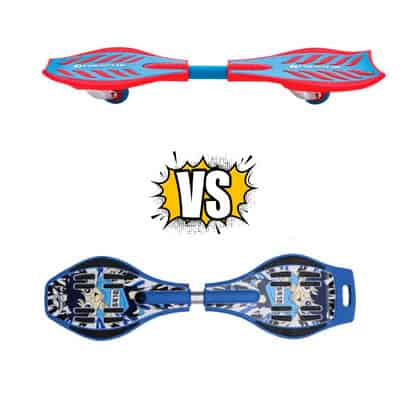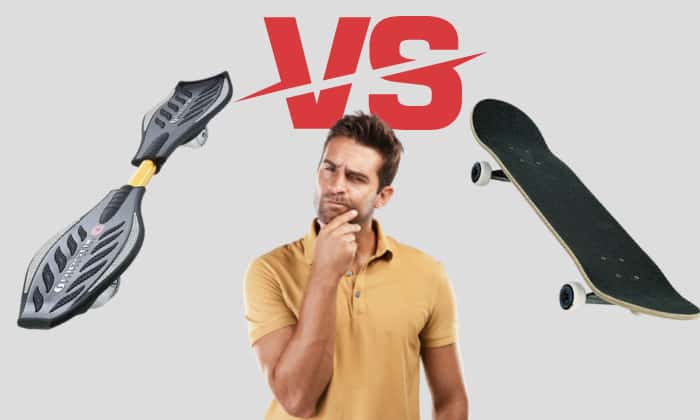Imagine skateboarding while heading to your friend’s house. Along the way, you saw another teen riding a uniquely flowy board with a bar in the middle. And what’s more unusual is that he did not push to drive. Later, you found out it’s a caster board he was using.
Now, caster board VS skateboard, which board is more fun to ride on? Will a skateboard surpass all the physical and performance aspects of a caster? How is the riding experience different on these boards?
This article will explore the core concepts of both pieces of equipment. And from there, we will assess which of the two will fit us best.
Table of Contents
Caster Boards and Skateboards in a Nutshell
We know that skateboards dominate the streets and many outdoor activities because of their benefits to the skater. But what is striking about skateboards?
These boards are pieces of oval wood installed with solid alloy trucks that roll on four wheels, but this mechanism makes them fun and worth riding. Skaters can grind on ledges, slide down ramps, or flip the skateboard for insane tricks.
Skateboards come in various deck widths and sizes, enabling potential and existing users to ride more comfortably. Ultimately, these boards are not only present on the streets as thousands of skate parks already exist worldwide.
On the other hand, what is a caster board?
A caster board, interchangeably called a waveboard, has its ends moving almost independently. That is because of a spring-loaded bar that allows the cross-cut decks to pivot through the middle part.
Flip this board, and you’ll see only a pair of casterboard wheels. And this is another aspect that makes this 2 wheeled skateboard unique.
Differences Between Caster and Skateboards
Both boards seem fun and thrilling at first glance. But let us dive deeper into their features and see how they differ.
1. Physical aspects
Let’s first begin with the appearance of both boards.
01 WheelsOf course, one of the first things we’ll notice is the number of these rollers, with four going for skateboards and only two for the caster board. Some people may find the latter’s setup weird, but practice lets riders get the hold of the board despite it having only a pair of rollers.
Looking closely at a skateboard wheel, it could be significantly smaller than caster boards. Skate wheels generally range from 48 to 60mm, while caster board ones are 68mm.
But despite being four, skateboard wheels seem more limited in mobility. Caster board rollers can rotate 360° through a pivot mechanism. Hence, riders achieve sharp and insane turns.
02 Deck styleAnother salient difference between caster boards and skateboards is their deck styles.
In skateboards, whenever the nose tilts, the tail follows. That means skateboard decks have a pretty simple longitudinal profile and a concave shape with rounded ends and parallel edges. Visually, they look more stable because of their grip tape and sufficient stepping surface.
Meanwhile, the caster or skateboard with two wheels is a bit on the stylish end. Compared to the straight edges of skateboard decks, these boards have a curved cut. With a torsion bar between the divided decks, users turn more sharply through this board.
A slight downside of caster boards is the absence of a solid grip tape. Nonetheless, they have curved patterns that help stabilize the rider’s feet.
2. Performance and execution aspects
Let us now identify the differences between using caster and skateboards.
01 Foot usageRiding a skateboard on momentum, we often find our feet seated on the deck with the arches facing each other. Otherwise, we use our back foot to push it forward. These are the usual foot movements we execute on a skateboard.
What about a caster board?
Virtually, there is no pushing necessary to ride a caster board. But since it’s not an electric board, how do we make it move?
Simple. Riders would often wiggle their front foot to propel the front end of the caster board. But to achieve that, the front foot should have enough power to swivel consistently.
02 BalancingFoot placement is pivotal in achieving balance on a caster board and skateboard.
Ideally, skateboarders should place their feet on top of the truck bolts regardless of whether they are regular or goofy-footed. Slightly bent knees will also contribute to stability.
For a caster or twist skateboard, the front foot should be above the center of the first half of the deck before the back foot moves onto the other half. While placing the back foot on the deck, lean your weight towards the front foot to balance. Riders must also consider their feel of the board and experiment to find a suitable stance.
03 Learning curveWe’ll surely learn both skateboarding and caster boarding in due time. But between these boards, which should you start first? What can you learn faster?
The basics we need for sports like these rest on skateboards mostly. These skills include getting on the board, balancing, stopping, and more. And indeed, these are the preparatory skills that lessen the time for us to ride the more complicated boards, like a caster board.
Caster boards are equally as fun as skateboards. But the timeline for mastering them depends on how much you have mastered the basics of skateboarding.
04 TricksWhich board can help you do more tricks?
Skateboards are more amenable to doing tricks. Whether on the ledge, ramp, or rails, skateboards can ace all stunts.
On the other hand, you can do almost the same skateboard tricks on a caster board, but not all. And that is because of its design.
3. Cost
While we don’t need to buy both caster and skateboards, we might as well consider their costs. Here are some prices of quality skateboards and caster boards in the market.
Caster board
- Tmore RipStik Caster Board – $72.99
- Razor RipStik Caster Board – $68.99
- Razor RIPSTER Mini Ripstik Ripster Caster Board – $155.55
Skateboard
- Cal 7 Complete Standard Skateboard – $49.99
- Anti Hero Classic Eagle Complete – $79.95
- Almost Skateboard Complete Neo Express Red – $89.95
4. Pros and cons
Let’s highlight the advantages and downsides we get from caster boards and skateboards.
- Good starter for more challenging boards
- Broad stepping surface
- Fully covered with grip tape
- Not as great for turning
- Smoother rides and sharper turns
- More stylish with curved, grippy patterns on the stepping surface
- Limited casterboard tricks execution
- Arguably more challenging to balance because of having only two wheels
5. Caster boards, Waveboards, Skateboards, RipStiks
Let’s have a few more comparisons among skateboards, RipStiks, waveboards, and caster boards.
01 RipStik VS skateboardSeveral areas distinguish skateboards from RipStiks and vice versa. Here are some of them.
-
- Design and wheel count – Four for skateboards, only two for RipStiks.
- Manner of riding – Pushing is necessary for skateboards while swiveling works on a RipStik.
- Skating places – The streets and parks are home to skateboards, and they are more maneuverable than RipStiks. You can ride RipStiks on driveways, in parking lots, and on smooth surfaces like asphalt.
- Turning ability – RipStiks can turn more because of their 360 casters.
- How much does a Ripstick cost? If you have around $100, you can already have a good one, same with skateboards.
Perhaps, this match-up is kind of confusing to many. In essence:
-
- Caster boards, like RipStiks, have more solid colors. On the other hand, waveboards have a more creative visual touch.
- Grip patches are more abundant with caster boards. Added balance is necessary for waveboards due to the absence of gripping pads on their deck.
Overall, caster and waveboards only differ in a few areas. And their operation modes are almost always the same.
Which One Should You Choose?
Caster boards and skateboards have rightful advantages and quite a few downsides. Both are desirable pieces of equipment for outdoor activities. But if we boil it down to choosing one first, we’ll be good with a skateboard. Why?
Things start with skateboards. From balancing to gliding and flipping decks, we can learn them by riding a skateboard.
And not to take credit from caster boards, but mastering the fundamentals of skateboarding will allow us to ride more efficiently.
Frequently Asked Questions
Is a RipStik or skateboard easier?
Many people will claim that RipStiks take more time to master than skateboards. But when considering the time needed to maneuver on a RipStik, we should emphasize that balance is also an added challenge.
Hence, with their steady stepping platforms, skateboards are on the much easier end. And with their four wheels compared to only two for RipStiks, control feels better on skateboards.
What is the difference between a waveboard and a caster board?
As mentioned, the only differences between wave boards and caster boards are more in their design. More specifically, these deviations are the colors and the grip patches on their decks.
Conclusion
Skateboards are only one thing that makes going outdoors more fun. Add the rise of waveboards, RipStiks, and caster boards, and skaters found more enjoyable ways to ride anywhere.
In this caster board VS skateboard review, we discussed several of their differences, from their physical to functional aspects. And indeed, both these boards serve specific advantages and benefits.
While skateboards are the best starters, there’s always room for more challenge in caster boards. So, plot your progress well, and never find a dull moment in the streets again.
Read more: Skater xl vs skate 3: Which is better?

Hi, I am Charles Harris. I opened this site to write as much as I can about my biggest passion – skateboarding!
I started as a clumsy yet passionate rookie 10 years ago to now a still passionate yet much better skateboarder! But I have to tell you, the whole journey has always been fun and rewarding, indeed not without hardship.


